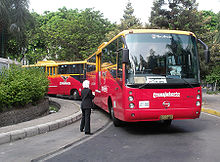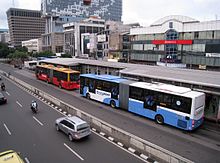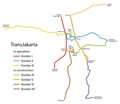TransJakarta
TransJakarta , or TJ / ti: dʒæɪ / for short, is the busway system installed in Jakarta . It is based on the TransMilenio system that was introduced very successfully in Bogotá and is currently in the process of being expanded.
overview
history
The first TransJakarta line, the so-called Corridor I, from Stasiun Kota Jakarta (Kota station) to Blok M (a bus station with an attached shopping center) was opened on January 15, 2004 with its 12.9 kilometers. Free travel was granted on the line during the first two weeks, so that commercial operations began on February 1, 2004.
There were some introductory issues such as B. a bus that rammed its roof into a railway underpass. There were also technical problems, such as not working doors or defective stop request buttons. But conceptual problems also had to be overcome. B. designed for the size of Europeans, so that most of the handholds could not be reached by the smaller Indonesians.
Most of these problems have now been resolved and TransJakarta has become a great success. Since April 21, 2005, women have also been employed as drivers at TransJakarta, but they always have to wear headscarves, as is appropriate on the Islamic island of Java .
The second line, Corridor II, which runs from the shared transfer point Harmoni to the Pulogadung bus station in the east of Jakarta, was opened on January 15, 2006. On the same date, the third line, Corridor III, was opened from the Kalideres terminal to the west via Harmoni to Pasar Baru (an important shopping street).
Corridors IV-VII were officially inaugurated on January 27, 2007 and began regular operations one day later. In contrast to the opening of Corridor I, there were no free tickets.
Corridor VIII followed on February 21, 2009, Corridor IX on December 31, 2009 and Corridor X on March 18, 2011.
This means that ten TransJakarta lines are currently in operation.
Passenger numbers
At the end of the second year of operation in 2005, 65,000 passengers / day were counted. This number almost doubled in just three months to 120,000 passengers / day in March 2006. Corridors II and III (i.e. the east-west axis) in particular showed particularly high increases in passenger numbers, while Corridor I (the north-south Axis) had a rather moderate increase in passengers. The projected passenger destination of the network opened up to now is 260,000 passengers per day.
Achieved goals
TransJakarta is recognized by both decision-makers and passengers as being highly efficient and comfortable, so that there is broad consensus in Jakarta that further expansion makes sense.
The system has not only led to significantly higher travel speeds in local public transport , it has also replaced several hundred buses that were mostly in traffic jams and were therefore highly inefficient for the operators. The environmental impact along the corridors implemented so far has improved: on the one hand, the old diesel buses have been replaced by the TransJakarta buses equipped with much better engine technology and, on the other hand, there are now fewer traffic jams in the rest of the traffic, as the earlier buses carried passengers in the most impossible places have picked up and dropped off, no longer operate.
In some cases, the TransJakarta system is already being attacked because of its success: since the buses travel much faster than the traffic on the other lanes in most times, there have already been several protests, rallies and road closures by taxi and minibus drivers who fear that that their business will be reduced by the TransJakarta buses.
business
Infrastructure on the track side
The essential element of the TransJakarta system is based on dedicated lanes for the buses. These are separated from the lane for the other vehicles by high curbs so that the buses can move forward unhindered in Jakarta's traffic, which is characterized by a lot of traffic jams . These lanes are clearly marked with "Khusus Busway" (special bus lane). At the intersections, the TransJakarta lanes are marked by red asphalt, which is intended to warn motorists not to block these areas.
However, there are also some places, mostly only a few hundred meters long, where there is mixed traffic with individual traffic . These points (especially the junctions with the normal lane) and the traffic lights that are not prioritized for the TransJakarta buses at the few intersections are obvious weak points of the system. They repeatedly lead to operational delays and long columns of vehicles. The buses build up and there is a cluster formation , which subsequently puts operations in an even more unstable state.
The Harmoni stop is the central transfer point of the system. Like many other stops, this is built over one of Jakarta's canals and has so far offered connections to all lines. The stop itself, however, is too small. Passengers not only crowd here at rush hour, and the transfer process through the stop is very difficult due to the many people in the narrow structure.
A standard tariff of 3,500 rupees (approx. 0.20–0.30 euros) applies throughout the TransJakarta system. It is possible to change trains at all stops that are served by several bus routes without buying another ticket.
vehicles
The buses have high-floor doors so that they can only stop at special stops equipped with elevated platforms for changing passengers. Since these bus stops are located on both sides of the vehicle, there is a door on both sides of the vehicle. The vehicles are fully air-conditioned and, thanks to appropriate maintenance, are in extremely good condition by Indonesian standards. These are mostly standard buses and some modern articulated buses are used, which are painted in the respective line color:
- red: Corridor I (Stasiun Kota Jakarta - Harmoni - Blok M)
- blue: Corridor II (Harmoni - Terminal Pulogadung)
- yellow: Corridor III (Pasar Baru - Harmoni - Terminal Kalideres)
- orange: Corridor IV / VII (Ancol Terminal Kp. Melayu - Kp. Rambutan)
The characteristic TransJakarta lettering and the mascot Jakartas (a Brahmin Weih (haliastur indus) with three salak fruits in its claws) are applied to the paintwork. The drivers all wear uniform. There is also a vehicle attendant in each of the buses who, however, does not wear a uniform, just a windbreaker and a hat with the TransJakarta logo.
High cruising speed
The high travel speed in the TransJakarta system is achieved as follows:
- Your own lanes, which allow unhindered progress, unaffected by the rest of the traffic.
- The lines along long main traffic axes that have few crossings and curves. In addition, the own driveway is mostly arranged in the middle of the street, so that there are no vehicles that turn in or out.
- Ticket sales and validation take place at the entrance to the stop so that there are no lost time in the vehicle.
- The stops in the middle of the street are in the vast majority of cases connected to pedestrian bridges, so that there is no pedestrian traffic on the busway lanes. However, there are hardly any escalators or lifts, so that the system can only be used by disabled passengers - if at all - under difficult circumstances.
- High-floor stops in combination with the bus-side doors, which enable passengers to change without having to overcome a time-consuming height difference
- Vehicle doors that are designed as fast-moving, double-leaf, wide sliding doors so that two passengers can get on and off in parallel without any problems
- No folding boards between the vehicle and the platform, so that no time is lost in folding out and in. However, this sometimes creates quite wide gaps between the vehicle and the platform.
- A vehicle attendant in every vehicle who, in addition to providing security and assistance in overcoming the gap, ensures that the passengers are first fully let out and that there is no loss of time due to the crowd in the door area.
- Furthermore, the vehicle attendant rejects passengers if the bus is already too full. This avoids holding times that are too long. Most of the time, the following bus is already in sight anyway, so that the passengers left behind do not lose too much time. It is generally the case that when there is overcrowding, many passengers like to wait for the next bus to be one of the first to get on the next bus and thus obtain a seat.
- The passengers, who usually jostle very quickly into the vehicle to secure a seat.
- The network configuration ensures that not too many passenger changes take place at the intermediate stops anyway. Mainly the connections between the central Stasiun Kota Jakarta or Harmoni stops and the bus stations (terminals) located at the terminals are used, from which traffic is further distributed to the individual parts of the city by several dozen city bus routes or long-distance buses to all of Java go off. On the other hand, there is little traffic at the intermediate stops.
Operational peculiarities
Some peculiarities and curiosities of the TransJakarta system:
- The vehicles only have one door on each side. As a result, on the one hand, the equipment at the stops is less complex and, on the other hand, the change of passengers can be secured by only one vehicle attendant per bus.
- Since the central transfer point is not approached by every line from all directions (see network plan), there are sometimes very strange transfer cascades. To get from Pasar Baru to Blok M, you have to z. B. first take the yellow line to Juanda or Pecenongan, then change to the blue line to Harmoni, and then finally take the red line to the Blok M. Corridor III in the direction of Kalideres cannot be reached directly from Harmoni. For this reason, most of the passengers take the yellow line for the "lap of honor" via Pasar Baru, as they would lose their seat if they were to change trains directly in Pecenongan.
- The stops are in a much worse condition than the well-maintained buses. Here comes z. For example, it often happens that the actual air conditioning system does not work or that the rubber bulges on the platform edge (secured with a sliding glass door) have been torn off, so that the already existing gap towards the vehicle must then inevitably assume widths of over 20 cm.
- When buying a ticket, you receive a chip card, which is immediately withdrawn at a turnstile that provides access to the bus stop. Presumably these smart cards form the first step towards the planned, future integrated traffic system of Jakarta , which is to include further TransJakarta, two monorail and an MRT line. The various S-Bahn lines operated by the Indonesian state railway are also to be integrated into the urban transport system.
- The discipline of the other road users is surprisingly high. It is very rare for cars or other buses to use the TransJakarta lanes to move faster. However, this may simply be due to the fact that at the points where the bus lanes merge into the normal street, there are very often police posts that pull such "nimble" drivers out of their lanes.
- TransJakarta conducts special training courses for school groups. For this purpose, special buses are used that are not available to other passengers. The aim of this training program is to teach the students the vehicles themselves, the orderly queuing in a row and a restrained behavior that is courteous to the older passengers.
Further system expansion
The Ancol - Terminal Kampung Melayu section of Corridor V and Corridor IV are scheduled to go into operation on January 5, 2007. In the final state in 2010, the system will then comprise 15 corridors.
Web links
- TransJakarta website (in Indonesian)

















